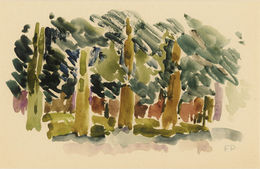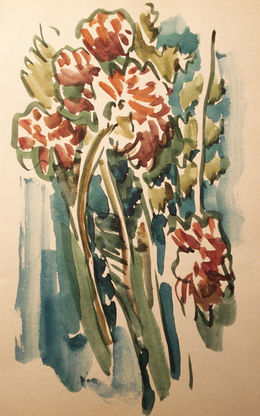

FELICIA PACANOWSKA
Pacanowska was born in 1907 in Lodz, a large Jewish industrial center in Poland, in an artistic family. After graduating high school in Lodz, Pacanowska is accepted at the School of Fine Arts in Warsaw, she graduates (painting and engraving) five years later. Woodcut as etching on copper, and painting are now vital elements of her life.
Pacanowska leaves Poland in 1932 to join the cluster of Jewish painters at the School of Paris. During months, she studies engravings at the “Cabinet” of the prints and drawings in the Louvre. Her life is difficult. In spite of that, she travels to Italy and England in 1935. She spends a few months in Poland where she exhibits fifty engravings and monotypes at the Institute of Art. Visiting her parents, the young woman does not foresee this visit would be her last: her parents will be exterminated by the Nazis.
Back in Paris in 1937, she perfects the technique of the etchings. At the beginning of the war, she works as a draughtswoman in an aircraft factory. During the occupation, she undergoes all the sufferings of persecution, and in 1942 she miraculously escapes the raid of the Vel' d'Hiv, (from the French abbreviation for Vélodrome d'hiver, or winter velodrome). Until the end of the war, Félicia Pacanowska lives under extremely precarious and dangerous conditions. All her artistic work and her work tools are lost. She reaches a supreme despair by learning the death of her parents. Her willingness to work maintains her alive.
During one year Félicia Pacanowska studies sculpture at the Academy of Rome. She returns to Paris in 1947 and starts again painting, drawing, etching, aquatinting and pastels painting. The artist considers these fields of equal value. She therefore participates in all major exhibitions: Salon d'Automne (Salon of Autumn), Salon des Independants (Independent Salon), Salon de Mai (May Salon), Salon des Réalitées Nouvelles (New Realities Salon), Jeune Gravure Contemporaine (Young Contemporary Engraving), Estampes Contemporaines (Contemporary Prints), Le Trait (the Feature), etc..
Her vision in her graphic work and her painting, initially figurative, tends little by little towards abstraction. The artist obtains important prices of engravings and her etchings are from now on well represented in public collections. The arrangement of her compositions, rigorously made, often evokes an origin cubist. Her work with the graver and etching strikes by the purity of the feature, the meticulous proportioning of black and white, the luminosity made of sobriety and sensitivity.
























